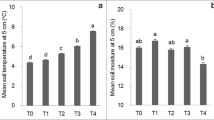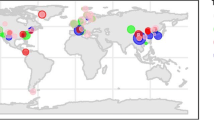Abstract
Manipulative experiments and space-for-time substitutions are two main approaches used to infer the impacts of future climate change on ecological processes, such as litter decomposition. The potential limitations of these approaches are well-recognized. Here, we address the congruence between these two approaches by comparing decomposition rates of leaf litter from four wetland plant species in response to (i) in-situ experimental warming (manipulative warming), and (ii) broad-scale spatial gradients (natural warming) over one-year observation of 2019. Manipulative warming was achieved by using open-top chambers (OTCs), and natural warming was followed along an altitudinal gradient from a high altitude site to a low site. Litter decomposition rates increased with temperature increasing in both OTC- and gradient-based approaches. However, litter decomposed faster along with the decreasing altitude than predicted by the manipulated rise in temperature, especially for those plants being resistant to decompose. For the gradient-based approach, the interaction effects between temperature and precipitation explained up to 44.1% of litter decomposition dynamics and served as a key to differentiate these two approaches. These results support the view that space-for-time substitution over broad-scale spatial gradients may magnify the responses of certain ecological processes to further climate warming. Our work is the first study to compare the characteristics of decomposition of wetland plant litter types in OTC- and natural gradient-based warming experiments.






Similar content being viewed by others
Data Availability
All data generated or analyzed during this study are included in this published article (and its supplementary information files).
Code Availability
Not applicable.
References
Ainley LB, Bishop MJ (2015) Relationships between estuarine modification and leaf litter decomposition vary with latitude. Estuarine Coastal Shelf Sci 164:244–252
Allison SD, Lu Y, Weihe C, Goulden ML, Martiny AC, Treseder KK, Martiny JBH (2013) Microbial abundance and composition influence litter decomposition response to environmental change. Ecology (Washington D C) 94:714–725
Allison SD, Vitousek PM (2004) Extracellular enzyme activities and carbon chemistry as drivers of tropical plant litter decomposition. Biotropica 36:285–296
Austin AT, Vivanco L (2006) Plant litter decomposition in a semi-arid ecosystem controlled by photodegradation. Nature 442:555–558
Beier C, Beierkuhnlein C, Wohlgemuth T, Penuelas J, Emmett B, Koerner C, de Boeck HJ, Christensen JH, Leuzinger S, Janssens IA, Hansen K (2012) Precipitation manipulation experiments - challenges and recommendations for the future. Ecology Letters 15:899–911
Blois JL, Williams JW, Fitzpatrick MC, Jackson ST, Ferrier S (2013) Space can substitute for time in predicting climate-change effects on biodiversity. PNAS 110:9374–9379
Boyero L, Pearson RG, Gessner MO, Barmuta LA, Ferreira V, Graça Manuel AS, Dudgeon D, Boulton AJ, Callisto M, Chauvet E, Helson JE, Bruder A, Albariño Ricardo J, Yule Catherine M, Arunachalam M, Davies JN, Figueroa R, Flecker AS, Ramírez A, Death RG, Iwata T, Mathooko JM, Mathuriau C, Gonçalves JF, Moretti MS, Jinggut T, Lamothe S, M’Erimba C, Ratnarajah L, Schindler MH, Castela J, Buria LM, Cornejo A, Villanueva VD, West DC (2011) A global experiment suggests climate warming will not accelerate litter decomposition in streams but might reduce carbon sequestration. Ecol Lett 14:289–294
Butenschoen O, Scheu S (2014) Climate change triggers effects of fungal pathogens and insect herbivores on litter decomposition. Acta Oecologica 60:49–56
Butenschoen O, Scheu S, Eisenhauer N (2011) Interactive effects of warming, soil humidity and plant diversity on litter decomposition and microbial activity. Soil Biol Biochem 43:1902–1907
Carlyle CN, Fraser LH, Turkington R (2011) Tracking soil temperature and moisture in a multi-factor climate experiment in temperate grassland: do climate manipulation methods produce their intended effects? Ecosystems 14:489–502
Deng H (2015) Prioritizing protection measures through ecosystem services valuation for the Napahai wetland, Shangri-La County, Yunnan Province, China. Int J Sustainable Dev World Ecol 22:142–150
Diffenbaugh NS, Giorgi F (2012) Climate change hotspots in the CMIP5 global climate model ensemble. Climatic Change 114:813–822
Duboc O, Zehetner F, Djukic I, Tatzber M, Berger TW, Gerzabek MH (2012) Decomposition of European beech and black pine foliar litter along an Alpine elevation gradient: mass loss and molecular characteristics. Geoderma 189-190:522–531
Elmendorf SC, Henry GH, Hollister RD, Fosaa AM, Gould WA, Hermanutz L, Hofgaard A, Jónsdóttir IS, Jónsdóttir II, Jorgenson JC (2015) Experiment, monitoring, and gradient methods used to infer climate change effects on plant communities yield consistent patterns. Proc Natl Acad Sci U S A 112:448–452
Fan ZX, Braumluning A, Thomas A, Li JB, Cao KF (2011) Spatial and temporal temperature trends on the Yunnan plateau (Southwest China) during 1961–2004. Int J Climatol 31:2078–2090
Fissore C, Giardina CP, Kolka RK, Trettin CC (2009) Soil organic carbon quality in forested mineral wetlands at different mean annual temperature. Soil Biol Biochem 41:458–466
Fraser LH, Henry HA, Carlyle CN, White SR, Beierkuhnlein C, Cahil JF Jr, Casper BB, Cleland E, Collins SL, Dukes JS (2013) Coordinated distributed experiments: an emerging tool for testing global hypotheses in ecology and environmental science. Front Ecol Environ 11:147–155
Geraldes P, Pascoal C, Cássio F (2012) Effects of increased temperature and aquatic fungal diversity on litter decomposition. Fungal Ecol 5:734–740
Guo LB, Sims REH (2001) Effects of light, temperature, water and meatworks effluent irrigation on eucalypt leaf litter decomposition under controlled environmental conditions. Appl Soil Ecol 17:229–237
Hartmann DL, Klein Tank AMG, Rusticucci M (2013) Climate change 2013: the physical science basis. Contribution of working group I to the fifth assessment report of the intergovernmental panel on climate change. Cambridge University Press, Cambridge
Hewins DB, Throop HL (2016) Leaf litter decomposition is rapidly enhanced by the co-occurrence of monsoon rainfall and soil-litter mixing across a gradient of coppice dune development in the Chihuahuan Desert. J Arid Environ 129:111–118
Hollister RD, Webber PJ (2010) Biotic validation of small open-top chambers in a tundra ecosystem. Glob Change Biol 6:835–842
Hudson JMG, Henry GHR (2009) Increased plant biomass in a high arctic heath community from 1981 to 2008. Ecology 90:2657–2663
Innangi M, Schenk MK, D’Alessandro F, Pinto S, Menta C, Papa S, Fioretto A (2015) Field and microcosms decomposition dynamics of European beech leaf litter: influence of climate, plant material and soil with focus on N and Mn. Appl Soil Ecol 93:88–97
Keiser AD, Bradford MA (2017) Climate masks decomposer influence in a cross-site litter decomposition study. Soil Biol Biochem 107:180–187
Kennedy AD (2010) Simulated climate change: are passive greenhouses a valid microcosm for testing the biological effects of environmental perturbations? Glob Change Biol 1:29–42
Liu G, Sun J, Tian K, Xiao D, Yuan X (2017a) Long-term responses of leaf litter decomposition to temperature, litter quality and litter mixing in plateau wetlands. Freshwater Biol 62:178–190
Liu J, Liu S, Li Y, Liu S, Yin G, Huang J, Xu Y, Zhou G (2017b) Warming effects on the decomposition of two litter species in model subtropical forests. Plant Soil 420:277–287
Maeda HA (2016) Tyrosine shortcut in grasses. Nat Plants 2(16080):16080
Makkonen M, Berg MP, van Logtestijn RSP, van Hal JR, Aerts R (2013) Do physical plant litter traits explain non-additivity in litter mixtures? A test of the improved microenvironmental conditions theory. Oikos 122:987–997
Olson JS (1963) Energy storage and the balance of producers and decomposers in ecological systems. Ecology 44:322–331
Pearson RG, Phillips SJ, Loranty MM, Beck PSA, Damoulas T, Knight SJ, Goetz SJ (2013) Shifts in Arctic vegetation and associated feedbacks under climate change. Nat Climate Change 3:673–677
Pithan F, Mauritsen T (2014) Arctic amplification dominated by temperature feedbacks in contemporary climate models. Nat Geosci 7:181–184
Preston CM, Nault JR, Trofymow JA, Smyth C, Grp CW (2009) Chemical changes during 6 years of decomposition of 11 litters in some Canadian Forest sites. Part 1. Elemental composition, tannins, Phenolics, and proximate fractions. Ecosystems 12:1053–1077
Salah YMS, Scholes MC (2011) Effect of temperature and litter quality on decomposition rate of Pinus patula needle litter. Proc Environ Sci 6:180–193
Salamanca EF, Kaneko N, Katagiri S (2003) Rainfall manipulation effects on litter decomposition and the microbial biomass of the forest floor. Appl Soil Ecol 22:271–281
Shaver GR, Canadell J, Chapin FS, Gurevitch J, Harte J, Henry G, Ineson P, Jonasson S, Melillo J, Pitelka L (2000) Global warming and terrestrial ecosystems: a conceptual framework for analysis. Bioscience 50:871–882
Sorte FAL, Lee TM, Wilman H, Jetz W (2009) Disparities between observed and predicted impacts of climate change on winter bird assemblages. Proc Biol Sci 276:3167–3174
Suseela V, Tharayil N (2018) Decoupling the direct and indirect effects of climate on plant litter decomposition: accounting for stress-induced modifications in plant chemistry. Glob Change Biol 24:1428–1451
Suseela V, Tharayil N, Xing B, Dukes JS (2014) Warming alters potential enzyme activity but precipitation regulates chemical transformations in grass litter exposed to simulated climatic changes. Soil Biol Biochem 75:102–112
ter Braak, C., and P. Šmilauer. 2002. CANOCO reference manual and users guide to Canoco for windows. Software for canonical community ordination (version 4.5):1-500
Tian K, Liu G, Xiao D, Sun J, Lu M, Huang Y, Lin P (2015) Ecological effects of dam impoundment on closed and half-closed wetlands in China. Wetlands 35:889–898
Vanholme R, Demedts B, Morreel K, Ralph J, Boerjan W (2010) Lignin biosynthesis and structure. Plant Physiol (Rockville) 153:895–905
Walter J, Hein R, Beierkuhnlein C, Hammerl V, Jentsch A, Schädler M, Schuerings J, Kreyling J (2013) Combined effects of multifactor climate change and land-use on decomposition in temperate grassland. Soil Biol Biochem 60:10–18
Wang H, Li HY, Ping F, Yue CL, Zhang ZJ (2016) Microbial acclimation triggered loss of soil carbon fractions in subtropical wetlands subjected to experimental warming in a laboratory study. Plant Soil 406:101–116
Wang H, Zhang Y, Chen G, Hettenhausen C, Liu Z, Tian K, Xiao D (2017) Domestic pig uprooting emerges as an undesirable disturbance on vegetation and soil properties in a plateau wetland ecosystem. Wetlands Ecol Manage 26:509–523
Wieder WR, Cleveland CC, Townsend AR (2009) Controls over leaf litter decomposition in wet tropical forests. Ecology 90:3333–3341
Wiens JA, Stralberg D, Jongsomjit D, Howell CA, Snyder MA (2009) Niches, models, and climate change: assessing the assumptions and uncertainties. Proc Natl Acad Sci U S A 106:19729–19736
Xiao D, Tian K, Yuan H, Yang Y, Li N, Xu S (2008) Distribution patterns and changes of aquatic plant communities in Napahai wetland in northwestern Yunnan plateau, China. Front Biol China 3:338–343
Yu S, Mo Q, Li Y, Li Y, Zou B, Xia H, Li ZA, Wang F (2019) Changes in seasonal precipitation distribution but not annual amount affect litter decomposition in a secondary tropical forest. Ecol Evol 9:11344–11352
Zhan P, Liu Y, Wang H, Wang C, Xia M, Wang N, Cui W, Xiao D, Wang H (2020) Plant litter decomposition in wetlands is closely associated with phyllospheric fungi as revealed by microbial community dynamics and co-occurrence network. Sci Total Environ 753:142194–142194
Zhao J, Zhang C, Deng L, Ren Y, Yan J, Luo Y, Zuo S, Zhang K, Wang H (2015) Impact of human activities on plant species composition and vegetation coverage in the wetlands of Napahai, Shangri-La County, Yunnan Province, China. Int J Sustainable Dev World Ecol 22:127–134
Funding
This work was supported by the National Natural Science Foundation of China (41877346), Yunnan Applied Basic Research Projects (2019FB036), and China Postdoctoral Science Foundation (2020 M671952).
Author information
Authors and Affiliations
Contributions
Study conception and design were performed by KT and HW. Data analysis was performed by WZC, HW and YQM. The first draft of the manuscript was written by WZC and HW. All authors read and approved the final manuscript.
Corresponding author
Ethics declarations
Ethics Approval
Not applicable.
Consent to Participate
Not applicable.
Consent for Publication
The work described has not been published before; it is not under consideration for publication anywhere else; its publication has been approved by all co-authors.
Conflicts of Interest/Competing Interests
No authors have any financial conflicts of interest or affiliations that might lead to conflicts of interest.
Additional information
Publisher’s Note
Springer Nature remains neutral with regard to jurisdictional claims in published maps and institutional affiliations.
Supplementary Information
ESM 1
(DOCX 16 kb)
Rights and permissions
About this article
Cite this article
Cui, W., Mao, Y., Tian, K. et al. A Comparative Study of Manipulative and Natural Temperature Increases in Controlling Wetland Plant Litter Decomposition. Wetlands 41, 48 (2021). https://doi.org/10.1007/s13157-021-01445-2
Received:
Accepted:
Published:
DOI: https://doi.org/10.1007/s13157-021-01445-2




